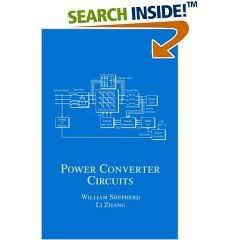
This manual is 'intended for junior and senior undergraduate courses', but it can be used by a much larger public. the large number of worked examples and exercises is very useful.
-IEEE Power Electronics Society Newsletter, Third Quarter, 2004
Electrical engineering students would find this book a good choice for the clarity and ease of understanding of the material presented. Teachers might want to consider this book as part of a course offering in power electronics.
-IEEE Electrical Insulation Magazine, Feb. 2005
The rectifier section contains excellent coverage of the theory on single-phase and three-phase circuits, controlled bridge rectifiers, and pulse-width modulation. There are numerous worked-out numerical examples. Electrical engineering students would find this book a good choice for the clarity and ease of understanding of the material presented.
-IEEE Electrical Insulation Magazine, Vol. 21, No. 1, Jan/Feb 2005
This is a classic handbook of Power Electronics, aimed for professors, undergraduate and graduate students in electrical, power and also electronic engineering, and for university libraries. Many worked examples and problems are included in each chapter, which are particularly useful for didactic purposes.
-IEEE Electronics Newsletter, Vol. 17, No. 4, 2005
Description
Power Converter Circuits reveals all key components of rectification, inversion, cycloconversion, and conversion circuits It describes switching, voltage, and current relationships, as well as converter properties, operation, control, and performance as utilized in most practical applications. Authored jointly by a veteran scholar and an accomplished researcher in the field, the book highlights methods grounded in classical mathematics and includes an abundance of worked numerical examples. Authoritatively covers AC to DC, DC to AC, AC to AC, and DC to DC converters in a single volume. Features hundreds of chapter-specific problems, with solutions provided separately at the end of the book.
0 comments:
Post a Comment